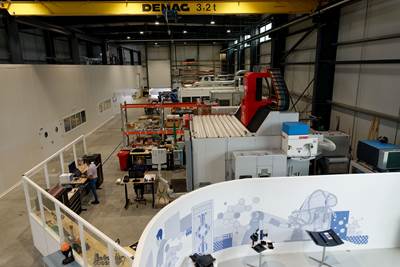Noncontact optical strain gage delivers complete 3D surface measurement insight
CAMX 2025: The Aramis system by Trilion, based on DIC and photogrammetry technology, performs high-precision measurements in the sub-micrometer range, across a wide range of testing environments and material types.
Share
Source | Trilion Quality Systems
Trilion Quality Systems’ (King of Prussia, Pa., U.S.) Aramis optical strain gage is a state-of-the-art, noncontact measuring solution designed to capture high-resolution full-field strain, 3D displacement and even vibration data with high precision. Unlike traditional strain gages or extensometers, Aramis is reported to deliver a vast amount of data in a fraction of the time, offering up to 100 times more measurement insight, while being up to 10 times more cost-effective and requiring 50 times less labor.
At the heart of Aramis lies 3D digital image correlation (3D-DIC), a highly accurate optical technique that uses digital image tracking and advanced correlation algorithms. By analyzing surface patterns (such as stochastic speckle patterns or point markers), the system maps 3D coordinates and calculates full-field strain and displacement with subpixel-level accuracy, often reaching microns of resolution. This makes it an ideal alternative to mechanical measuring tools, especially when precision, repeatability and versatility are critical.
The Aramis system is completely material-independent, making it highly adaptable for use across a wide range of testing environments and material types. Its flexibility and robust capabilities make it optimal for finite element analysis (FEA) validation, material characterization, fatigue and durability testing, structural health monitoring and dynamic testing using high-speed cameras.
According to Trilium, industries ranging from automotive and aerospace to biomechanics and civil engineering rely on Aramis for accurate, efficient and comprehensive optical measurement. Whether conducting tensile tests, crash simulation or real-world operational analysis, the optical strain gage enables engineers and researchers to see how materials and structures behave in three dimensions, down to the smallest detail.
Aramis is also easy to integrate into existing test setups and workflows. From small-scale lab environments to large structural tests, the system delivers scalable performance and reliable results. Users benefit from fast test cycles, enhanced data visualization and simplified reporting — all of which support smarter engineering decisions.
Related Content
-
AIMM Center for advanced composites NDT opens in Ogden, Utah
Attendees from SpaceX, Northrop Grumman, Hill AFB, 47G and others joined CICNDT and Omni NDE to demonstrate the latest in robotic CT, RT, shearography, thermography, laser UT and metrology.
-
Laser-excited acoustics provide contact-free, nondestructive composites inspection
Xarion’s couplant-free NDT technology uses laser physics and a membrane-free optical microphone, eliminating the requirement for fluid coupling, widening the scope for NDT technology.
-
Schrödinger advances materials informatics for faster development of next-gen composites
Cutting time to market by multiple orders of magnitude, machine learning and physics-based approaches are combined to open new possibilities for innovations in biomaterials, fire-resistant composites, space applications, hydrogen tanks and more.
Related Content
AIMM Center for advanced composites NDT opens in Ogden, Utah
Attendees from SpaceX, Northrop Grumman, Hill AFB, 47G and others joined CICNDT and Omni NDE to demonstrate the latest in robotic CT, RT, shearography, thermography, laser UT and metrology.
Read MoreLaser-excited acoustics provide contact-free, nondestructive composites inspection
Xarion’s couplant-free NDT technology uses laser physics and a membrane-free optical microphone, eliminating the requirement for fluid coupling, widening the scope for NDT technology.
Read MoreSchrödinger advances materials informatics for faster development of next-gen composites
Cutting time to market by multiple orders of magnitude, machine learning and physics-based approaches are combined to open new possibilities for innovations in biomaterials, fire-resistant composites, space applications, hydrogen tanks and more.
Read MorePhotothermal tomography for locating, quantifying defects in composites
Years of infrared testing development result in thermography technology that is no longer just qualitative, but can define defect size and depth, making additional UT scans obsolete.
Read MoreRead Next
CactuX in-situ BOX simulates real-life conditions of composite samples during CT analysis
The autonomous in-situ BOX combines the environment temperature control function and power supply function, enabling new possibilities for material and internal structure research.
Read MoreInstron launches AVE3 noncontact video extensometer
Leveraging CDAT airflow technology and dynamic lighting, the AVE3 delivers a virtually noise-free strain signal, guarding against typical air disturbances when measuring materials in the lab.
Read MorePlant tour: Daher Shap’in TechCenter and composites production plant, Saint-Aignan-de-Grandlieu, France
Co-located R&D and production advance OOA thermosets, thermoplastics, welding, recycling and digital technologies for faster processing and certification of lighter, more sustainable composites.
Read More









